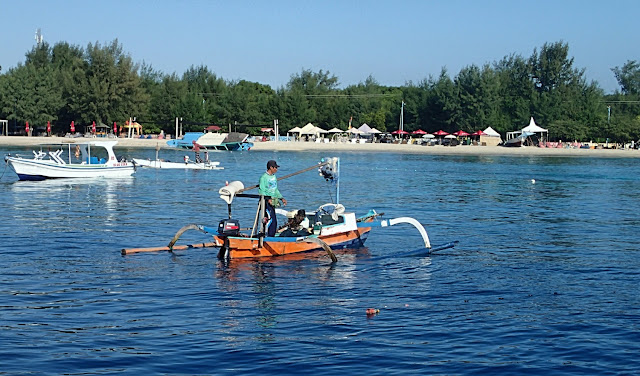When we got back to Medana Bay we discovered that Eid holidays were
about to begin and last for about a week. So we decided to leave
Pegasos on a mooring at Medana Bay and go hang out in Bali again for
a week. The biggest difference between Bali and Lombok is that Bali
is mostly Hindu and Lombok is mostly Muslim, making Bali a much more
inviting place to be.
We took a ferry from Bangsal to Padang Bai. Ferry operators are
cutthroat and prices are not fixed, it depends on how much effort you
put into comparing and negotiating at the port. We discovered that
buying a ticket at the port was cheaper than on-line.
Padang Bai is a heaving mass of ferries, passengers, taxi touts and
people carrying anything - such as a large swordfish.
It was hot and after checking in at hotel we went for a swim at White
Sands Beach - a misnomer.
The next morning the hotel staff were very enthusiastic about
arranging a taxi for us at a rather inflated price so we compared
prices and decided on Grab - the Uber version of rideshare in Bali.
This has to be done discreetly as local taxis hate competition and
can attack Grab drivers. Most hotels won't allow Grab near them so
slick is the hotel/taxi mutual partnership. There are certain hotel
lined roads banning online taxis.
So we waited a short distance from the hotel until the car appeared,
slowed down and the driver said "Quick, get in quickly" and
we were off in a flash. A friendly, chatty driver made our journey of
over an hour to Ubud interesting. There is no open countryside along
the main roads and one town blends into the next.
Ubud is much busier than we expected with throngs of tourists,
hotels, restaurants, and zillions of shops selling handcrafts that
Bali is known for, as well as many art galleries and studios teaching
art and wood carving. Temples and shrines are everywhere.
We visited the Monkey Forest Sanctuary in the heart of Ubud. It's a
well maintained green jungle space, home to about 900 monkeys. There
are long-tailed monkeys everywhere who are very used to people moving
amongst them.
There are 3 temples in the Monkey Forest - the cremation temple has
particularly disturbing statues.
We also visited the Agung Rai Museum of Art situated in a large green
shady area with many trees and water features. There are 2 galleries,
one is for traditional art - a fascinating display of intricate,
finely detailed, busy Balinese paintings.
Rice paddies are everywhere, even next to our hotel in the middle of
Ubud. We decided to see the famous Tegallalang rice terraces and
hired a scooter for the day.
The countryside is lush and green and we enjoyed the scenic drive.
The countryside is lush and green and we enjoyed the scenic drive.
We were expecting a quiet village surrounded by rice terraces.
Instead we got hillside rice terraces completely overwhelmed by
tourists, taxi touts, jam-packed stalls selling trinkets and pushy
young postcard sellers.
We found a lunch spot further away to get photos that didn't include
zip lines and swings, a nice view.
On our way back into Ubud we visited the Elephant Cave (Goa Gajah)
temple which dates back to 8th century. Wearing a sarong is
obligatory.
We booked a stay in a coffee plantation further away north near
Kintamani, a village close to Mount Batur, an active volcano. Our
barn type accommodation was literally in the coffee plantation.
We walked on the edge of an old massive black lava field - it's lunar
surface in sharp contrast to surrounding vegetation. Our host told us
about the eruptions and formation of the lava field which poured into
a village on the lava path.
The coffee plantation also makes the famous coffee via civet cat
"processing" and we met a 5 month young civet cat. Cute but
perhaps they would be happier in the wild.
A long drive back to Padang Bai for the night and the morning ferry back to Lombok and Pegasos.
We got back at spring low tide - an occasion where the villagers forage on the exposed sea grass flats collecting sea urchins and other delicacies.
The haul out of Pegasos went very smoothly. It was the first
multihull haul out for Medana Bay Marina with the general manager
Suraya getting into the water for a true hands on supervision. We
were all happy with the process and after a wash down and preliminary
scrape, Pegasos was maneuvered into its parking spot.
First the job of anti-fouling - luckily we had a willing assistant
for the scraping and painting leaving Robert free to design a
mounting bracket for a spare outboard engine for back up to our
inboard engine. This also means drilling some holes through the side
of the main hull - yikes!
The scraping and painting took about 4 days and Pegasos looks
re-freshed. Pegasos will stay on the hard until early September.
We're off back home for 2 months and plan to join the Sail2Indonesia
rally in September going through to Malaysia - an exciting adventure
to look forward to.






















































































